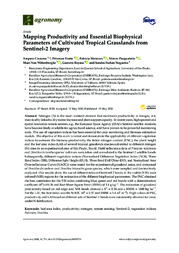Mapping productivity and essential biophysical parameters of cultivated tropical grasslands from sentinel-2 imagery.
Mapping productivity and essential biophysical parameters of cultivated tropical grasslands from sentinel-2 imagery.
Author(s): CISNEROS, A.; FIORIO, P. R.; SANTOS, P. M.; PASQUALOTTO, N.; WITTENBERGHE, S. van; SILVA, G. B. S. da; NOGUEIRA, S. F.
Summary: Abstract: Nitrogen (N) is the main nutrient element that maintains productivity in forages; it is inextricably linked to dry matter increase and plant support capacity. In recent years, high spectral and spatial resolution remote sensors, e.g., the European Space Agency (ESA)?s Sentinel satellite missions, have become freely available for agricultural science, and have proven to be powerful monitoring tools. The use of vegetation indices has been essential for crop monitoring and biomass estimation models. The objective of this work is to test and demonstrate the applicability of different vegetation indices to estimate the biomass productivity, the foliar nitrogen content (FNC), the plant height and the leaf area index (LAI) of several tropical grasslands species submitted to different nitrogen (N) rates in an experimental area of São Paulo, Brazil. Field reflectance data of Panicum maximum and Urochloa brizantha species' cultivars were taken and convoluted to the Sentinel-2 satellite bands. Subsequently, different vegetation indices (Normalized Difference Vegetation Index (NDI), Three Band Index (TBI), Difference light Height (DLH), Three Band Dall?Olmo (DO), and Normalized Area Over reflectance Curve (NAOC)) were tested for the experimental grassland areas, and composed of Urochloa decumbens and Urochloa brizantha grass species, which were sampled and destructively analyzed. Our results show the use of different relevant Sentinel-2 bands in the visible (VIS)-near infrared (NIR) regions for the estimation of the different biophysical parameters. The FNC obtained the best correlation for the TBI index combining blue, green and red bands with a determination coefficient (R2) of 0.38 and Root Mean Square Error (RMSE) of 3.4 g kg-1. The estimation of grassland productivity based on red-edge and NIR bands showed a R2 = 0.54 and a RMSE = 1800 kg ha-1. For the LAI, the best index was the NAOC (R2 = 0.57 and RMSE = 1.4 m2 m-2). High values of FNC, productivity and LAI based on different sets of Sentinel-2 bands were consistently obtained for areas under N fertilization.
Publication year: 2020
Types of publication: Journal article
Observation
Some of Embrapa's publications are published as ePub files. To read them, use or download one of the following free software options to your computer or mobile device. Android: Google Play Books; IOS: iBooks; Windows and Linux: Calibre.
Access other publications
Access the Agricultural Research Database (BDPA) to consult Embrapa's full library collection and records.
Visit Embrapa Bookstore to purchase books and other publications sold by Embrapa.

